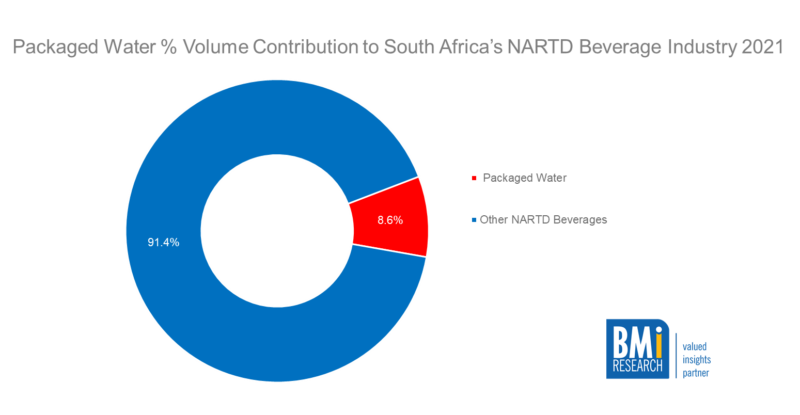Bottled water has snatched the lion’s share of the non-alcoholic beverage market in the United States, surpassing the record that carbonated soft drinks previously held.
This was recently announced by Beverage Market Corporation at The Packaging Conference taking place in in Austin, Texas. According to the research and consulting firm, bottled water made up nearly 25% of the US beverage market in 2021.
In South Africa, bottled water’s share – more correctly, ‘packaged water’s share’, as our legislation refers to bottled water as ‘packaged water – is far less with it comprising just 8.6% of the entire non-alcoholic ready-to-drink (NARTD) beverage market, as this graph from BMi Research shows.
According to BMi Research, despite recording a positive compound annual growth rate for volume sold over the last five years from 2016 to 2021, packaged water’s percentage volume contribution to the total NARTD market has waned because of the strong growth achieved by, especially, ready-to-drink energy options.
And, as with so many sectors, consumption was impacted by the Covid pandemic.
Summarising South Africa’s packaged water category pre-lockdowns and restrictions, BMi Research said increased demand had increased the category’s contribution to the overall NARTD beverage industry over the last 10-15 years.
This demand was believed to be primarily driven by bottled water’s lower average selling price when compared to other NARTD beverages, an ever-improving number of quality brands available in South Africa, increased consumer knowledge and comfort around consuming packaged water to the extent that it had become a lifestyle product, convenience particularly for active consumers and perceived health benefits of consuming packaged waters as opposed to other NARTD beverages, and finally some concern about the quality of municipal drinking water.
Interestingly, demand for packaged water was only briefly deterred by selected instances of drought over the last few years.
Consumption of packaged water was unfortunately under pressure during Covid, as was consumption of other NARTD beverages. This was attributed to the fact that consumers were largely at home, not in their cars, not training nor exercising and generally not active while restrictions on consumer out-of-home activities, like eating out, removed prominent packaged water consumption occasions. And, when at home, consumers opted to consume tap water, rather than purchase packaged beverages, as consumer spending decreased during Covid.
With easing of restrictions towards the end of 2021, many expected the consumption of packaged waters and other beverages to increase again. However, the relatively colder and wetter end to the year – a popular consumption period, again negated packaged water sales along with those of other NARTD beverages, says BMi Research.
On the positive front, it anticipates demand for packaged water to be positive over the medium to longer term. Here, it believes the above-mentioned pre-Covid drivers, along with an ever-improving local economy as consumer spending improves will drive sales.
“This is good news for our industry,” says SANBWA CEO Charlotte Metcalf. “Our members look forward to improving their sales to a point where they regain – and then exceed – their previous share of the NARTD beverage market.
“When they are ready to dig into their pockets and purses to purchase bottled water again, SANBWA urges consumers to reach for a brand displaying the SANBWA logo because all SANBWA members adhere to SANBWA’s world class bottled water standard.
“This logo, inspired by an ostrich egg used by the San Bushmen as containers and for carrying water, symbolises our values of honesty and integrity, but the natural, safe content of the water, its African origins and also offers consumers peace of mind.
“It offers the consumer peace of mind that the product is from a source that has been vigorously checked for the absence of contamination and pollution, that the bottling facility is hygienic and operated according to good manufacturing practices, and that the necessary procedures are in place to ensure the quality of the product.
“It also guarantees that the product is genuine natural mineral or spring water, and that the source is sustainable. If the bottle a consumer reaches for does not have the SANBWA logo on the label they should ask themselves ‘why not?’,” Metcalf says.
ends
Issued on behalf of SANBWA – Charlotte Metcalf – CEO
